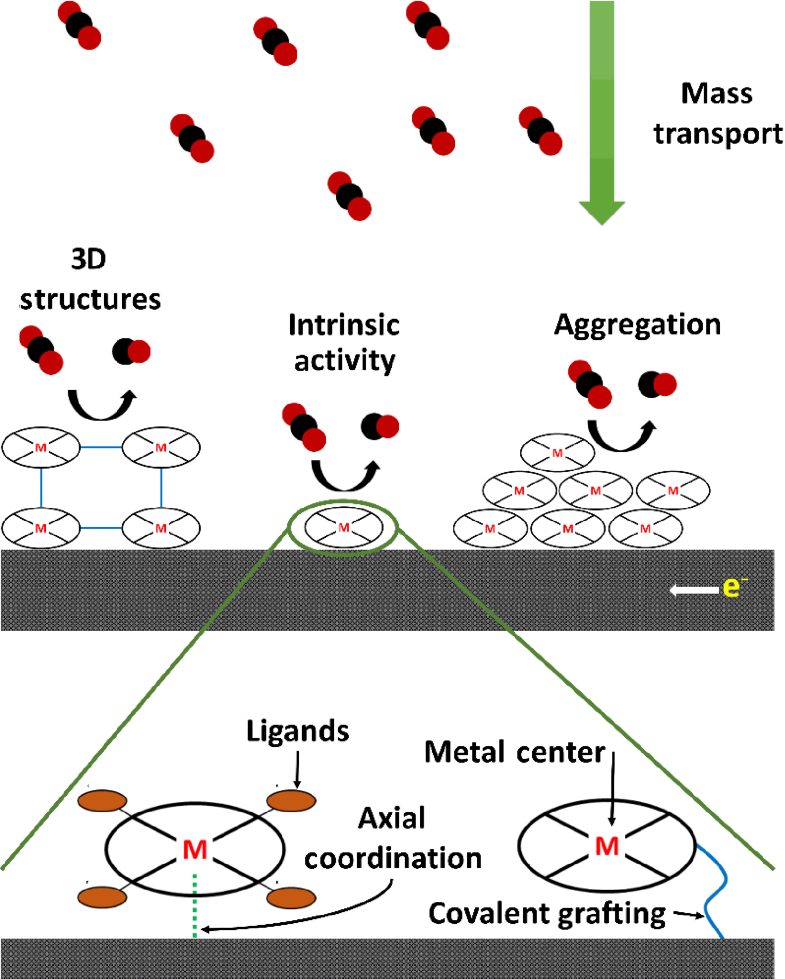Nano Research ( IF 9.5 ) Pub Date : 2019-05-01 , DOI: 10.1007/s12274-019-2403-y Nathan Corbin , Joy Zeng , Kindle Williams , Karthish Manthiram
This review provides an overview of the literature regarding heterogeneous molecular catalysts for electrochemical CO2 reduction (ECR). Fundamental aspects of the science, including aggregation, electrochemical rate laws, and electrode-catalyst electronic coupling, are discussed to provide a solid foundation on which to design experiments and interpret results. Mechanistic aspects of ECR are presented based on electrokinetic and spectroscopic measurements as well as density functional theory (DFT) calculations. Consensus is improving for electrokinetic measurements, but the redox state of the metal center under reaction conditions and DFT reaction pathways lack agreement in the literature. Concerning the tunable aspects of the molecular catalyst, the impacts of the metal center, ligand substituents, and electrode support on the activity and selectivity toward ECR are presented with an emphasis on those studies that controlled for aggregation and minimized mass-transport limitations. Extended three-dimensional (3D) structures such as polymers, metal-organic frameworks (MOFs), and covalent-organic frameworks (COFs) are discussed as highly tunable architectures that begin to mimic the catalytic pockets of enzyme active sites. To achieve the full potential of these catalysts, design principles must emerge based on a combination of deconvoluting measurements to extract intrinsic catalyst properties and more reliable theoretical calculations to predict reaction pathways.

中文翻译:

电催化CO的非均相分子催化剂
这篇综述提供了有关电化学CO 2的非均相分子催化剂的文献综述。减少(ECR)。讨论了该科学的基本方面,包括聚集,电化学速率定律和电极-催化剂电子偶联,为设计实验和解释结果提供了坚实的基础。基于电动和光谱测量以及密度泛函理论(DFT)计算,介绍了ECR的机械方面。电动测量的共识正在改善,但是在反应条件和DFT反应途径下金属中心的氧化还原状态在文献中缺乏共识。关于分子催化剂的可调方面,金属中心,配体取代基,以及电极对ECR活性和选择性的支持,重点放在那些控制聚集和最大程度地限制物质传输限制的研究上。扩展的三维(3D)结构(例如聚合物,金属有机框架(MOF)和共价有机框架(COF))作为高度可调节的结构进行了讨论,这些结构开始模仿酶活性位点的催化口袋。为了充分发挥这些催化剂的潜力,必须结合去卷积测量以提取出催化剂的固有性能以及更可靠的理论计算来预测反应路径,从而得出设计原则。和共价有机框架(COF)被讨论为高度可调节的体系结构,开始模仿酶活性位点的催化口袋。为了充分发挥这些催化剂的潜力,必须结合去卷积测量以提取出催化剂的固有性能以及更可靠的理论计算来预测反应路径,从而形成设计原则。和共价有机框架(COF)被讨论为高度可调节的体系结构,开始模仿酶活性位点的催化口袋。为了充分发挥这些催化剂的潜力,必须结合去卷积测量以提取出催化剂的固有性能以及更可靠的理论计算来预测反应路径,从而得出设计原则。
































 京公网安备 11010802027423号
京公网安备 11010802027423号